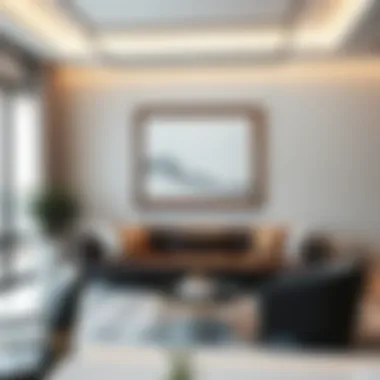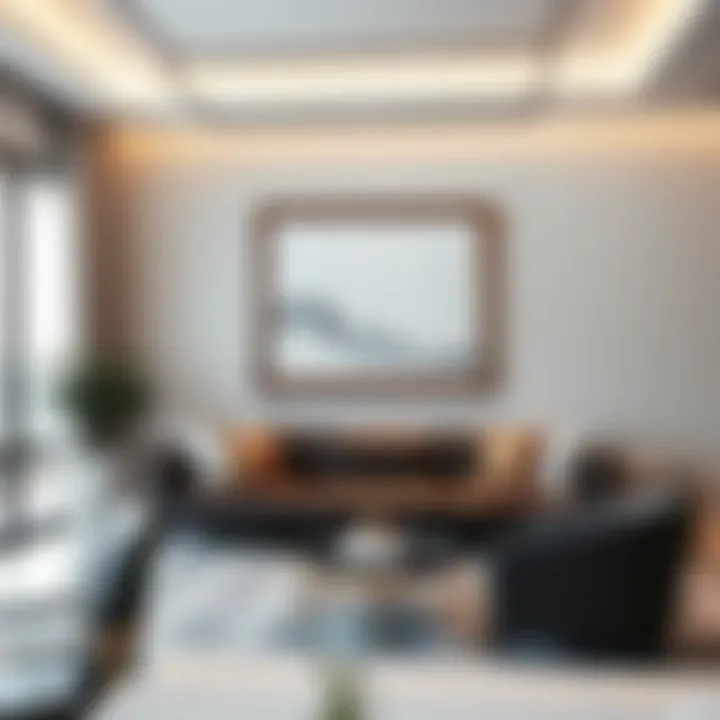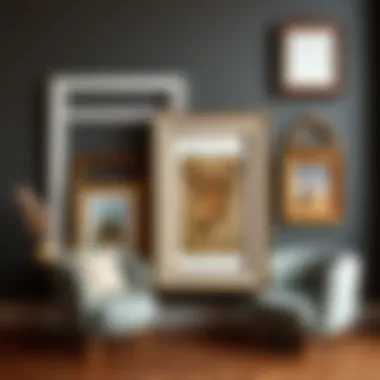Dimensions and Aesthetics of 30x48 Picture Frames


Intro
When you think about decorating your home, picture frames often get overshadowed by larger furniture pieces and bold wall colors. However, a 30 x 48 picture frame holds more significance than merely encasing a photograph or artwork. It can be the centerpiece that ties an entire room together, showcasing personal moments or exquisite art that reflects your taste and personality. When chosen correctly, these frames can enhance not only the visual appeal of the space but also the emotional resonance it carries.
Furniture Design Trends
In the evolving sphere of interior design, picture frames are becoming not just functional items but also significant design elements that influence the aura of a room. As homeowners increasingly seek expressive ways to customize their spaces, understanding the trends around picture framing is essential.
Trending Materials and Textures
The right material can make or break the aesthetic of a frame. Traditionally, wood frames were a staple, bringing warmth and a classic feel to any decor. Nowadays, metal frames are also gaining ground, exuding a modern elegance with their sleek profiles.
- Wood: Its natural grains add depth; consider oak for a rustic touch or maple for a more contemporary vibe.
- Metal: Available in various finishes, aluminum or brass can introduce a striking contrast against softer décor.
- Acrylic: Often mistaken for glass, with its lightweight and shatter-resistant properties, acrylic frames are becoming popular in modern homes.
- Composite Materials: These mix styles - think of a wooden frame wrapped around a metallic outlook, crafting an interesting visual.
The texture, too, plays a critical role. A smooth finish provides a clean look, while distressed surfaces might evoke a homely, lived-in feel.
Color Palettes and Styles
When pondering the colors and styles of a frame, it’s imperative to consider both the artwork it will hold and the surroundings.
Color Harmony: A frame shouldn’t disrupt the flow of a room. Instead, it should complement existing colors.
- Neutral Tones like black, white, or beige provide versatility, adapting to whichever style of artwork they enclose.
- Bold Colors can draw attention to the frame itself, making it a focal point. Think of a navy blue frame against a sun-kissed wall.
Styles:
The frame style should match the overall theme of the space.
- Classic: Ornate frames with almost baroque designs suit traditional décors.
- Minimalistic: Simple, clean lines align well with modern aesthetics.
- Eclectic: Mix and match different styles for a lived-in, personalized look.
"Choosing the right picture frame is not just about protecting your artwork; it's an art in itself, blending style, material, and the colors of your space to weave a harmonious narrative."
Established trends underscore the importance of these elements in ensuring your frames resonate with your overall home theme. Think of them as not just holders of art but as expressions of life experiences and personal aesthetics.
Practical Tips for Selecting A Picture Frame
Assessing Space and Functionality
Before diving into the world of frames, assess your space. A 30 x 48 frame might be substantial, so identifying the right wall and context is crucial.
- Wall Size: Large frames work well on expansive walls. Conversely, on smaller walls, consider smaller sections or groupings to avoid overwhelming the space.
- Surrounding Elements: Take into account furniture and decor. A frame should coexist with its surroundings; it should not feel isolated.
- Lighting: Think about how natural and artificial light illuminates the frame. A poorly lit picture can lose its charm.
Balancing Aesthetics with Comfort
A picture frame is destined to be part of your home, not just a solo actor on stage. It should feel right in its environment.
- Combining Textures: If your room has soft fabrics, consider a smooth frame. In contrast, for a room with hard surfaces, adding a wooden frame may soften the atmosphere.
- Visual Flow: Ensure the frame’s style aligns well with other decor elements in the room. If the room embodies a contemporary design, a vintage frame might seem out of place.
In summary, selecting a 30 x 48 picture frame is about much more than the picture it contains. It’s about creating a cohesive narrative within your home. By understanding material trends, colors, and the practical aspects of selection, you can choose a frame that serves as both an aesthetic statement and a beloved vessel for cherished memories.
Preamble to Picture Frames
Picture frames often play a critical role in enhancing the visual appeal of our living spaces. They act not merely as holders for our cherished images or works of art, but also as significant elements in the overall design of a room. When one thinks of a picture frame, it is worth remembering that this is the first layer of presentation - it’s what draws the eye and prepares the viewer for what lies within. The 30 x 48 picture frame, in particular, is not typical in dimensions. It’s a statement piece that can capture attention and ignite conversation, combining both form and functionality in a way that smaller frames might not.
Importance of Picture Frames in Home écor
In home décor, the right picture frame can harmoniously tie together aesthetics, reflecting personal style and taste. Choosing to showcase artwork or photographs in a well-selected frame can transform bland walls into dynamic displays. Picture frames don’t just hold images; they set the mood of a space. For instance, a rustic wooden frame can evoke warmth and nostalgia, fitting seamlessly in a country-style kitchen, while a sleek metal frame fits perfectly in a modern minimalist living room. The potential for creativity is vast, with frame choices adding layers of sophistication, depth, and dimension to interior spaces.
- Frames serve as a transitional element between the artwork and the environment.
- They help in creating visual balance, serving as anchors around which design elements can coalesce.
- The type of material and color can set an overall tone, whether inviting or formal.
The Functionality of Frames Beyond Aesthetics
While aesthetics are undoubtedly important, frames fulfill practical roles as well. They protect artwork or photographs from dust, moisture, and damage. A sturdy frame can keep photographic prints looking fresh for years, preserving memories without fading into obscurity. For larger dimensions like 30 x 48, select frames often include additional support mechanisms to prevent warping or bending over time.
"A good frame not only enhances an image but also safeguards it for generations."
Furthermore, certain frames feature versatile hanging options, allowing homeowners to easily rearrange or hang their pieces according to their mood or seasonal trends. Mobile and adaptable, these frames let you create unique arrangements and displays that can evolve over time.
In summary, picture frames are indispensable in home decoration, as they not only beautify and highlight the art but also serve essential functions such as protection and flexibility. In the following sections, we dive deeper into the dimensions, materials, styles, and further aspects of the 30 x 48 picture frame to understand their full potential in your living environment.
Understanding the Dimensions of x Frames
When it comes to picture frames, the dimensions play a crucial role in both functionality and aesthetics. Specifically, a 30 x 48 frame holds its own unique position in the world of display options. Understanding its dimensions allows homeowners and designers alike to make educated decisions that align the artwork's intentions with their home’s decor.
Standard Sizing Explained
A 30 x 48 picture frame is not just a random measurement; it is a common size that brings a balance of presence and versatility in displays. This size typically caters well to a range of art forms, from large photographs to intricate artwork. It's a sizable frame that can stand out in both tight spaces and expansive walls.
When one considers standard sizing, we often think about the artwork that’ll be placed inside the frame. With the right sizing, viewers can appreciate the details of the art without feeling overwhelmed by a frame that dominates the space, or one that is too small to have any impact.
- Proportion: Larger frames emphasize the piece in a way that invites the eye. With a 30 x 48 frame, art becomes more than just decoration—it captures attention and elevates the aesthetic value of a room.
- Popular Uses: Think of how a large art piece can function in spaces like living rooms, hallways, or even as a statement piece in an office. This size often finds its place in galleries, making it a trusted choice for those looking to showcase art.
Incorporating this dimension into your decor allows for effective use of wall space—especially when opting for showcasing multiple pieces in different arrangements.
Visual Impact of Size in Framing
The visual impact of a frame’s size cannot be understated. A 30 x 48 frame works wonders in creating focal points in any room. The sheer size can command attention, but it also requires careful consideration of the surrounding environment to ensure cohesiveness.


- Balance: A well-placed 30 x 48 frame can serve as an anchor in a room. It draws the eye and provides a sense of balance, especially when paired with smaller frames or other decorative elements.
- Contrast and Harmony: The juxtaposition of a large frame against smaller decor elements can create a dynamic interplay that elevates the overall aesthetic experience. For example, a tall frame against a low furniture piece can establish visual interest.
Furthermore, the subject matter chosen for a 30 x 48 frame can influence its effectiveness:
- A striking landscape photograph might evoke serenity,
- A vibrant abstract painting could inject energy.
"Art is not what you see, but what you make others see." - Edgar Degas
Thus, it is essential to consider how size influences perception; a properly sized frame enriches the art and the space it occupies.
Material Choices for x Picture Frames
Choosing the right material for a 30 x 48 picture frame can significantly impact not only the aesthetics but also the functionality and longevity of your artwork display. Frames are more than just a border; they're the accent piece that can elevate the art within. This section will explore the most popular materials: wood, metal, and plastic. Understanding the characteristics of each type helps homeowners and designers make informed decisions, tailored to their particular style and budget.
Wood Frames: A Classic Choice
Wood frames have been around for ages, and for good reason. They carry a warmth and authenticity that can beautifully complement various types of artwork. Different woods, such as oak, cherry, or pine, offer unique grains and colors that can enhance the visual impact of any piece.
- Durability: Properly finished wooden frames can last a lifetime. They resist warping and cracking better than many alternatives.
- Versatility: From rustic to elegant finishes, wood frames can fit seamlessly into any decor theme.
- Customizability: Carving and staining wood allows for endless design possibilities. You can really put a personal touch on the frame.
However, wooden frames need proper care to maintain their beauty over time. Make sure to avoid direct sunlight to prevent fading, and clean with a soft, dry cloth to avoid damaging the finish.
Metal Frames: A Modern Aesthetic
Metal frames are often the go-to choice for contemporary art or photos. They provide a sleek, streamlined look that many find appealing. The reflective surface can also add a dynamic element to your wall art.
- Contemporary Look: Stainless steel or aluminum frames add a modern touch that enhances rather than distracts from artwork.
- Lightweight: Metal frames tend to be lighter than wooden ones, making them easier to handle and hang.
- Resilience: Corrosion-resistant finishes protect against factors like humidity. This is particularly advantageous for areas like kitchens or bathrooms.
Despite their advantages, metal frames can sometimes lack the warmth that wood provides, possibly leading to a colder feel in more intimate spaces. Yet, when styled appropriately, they can serve as an elegant contrast.
Plastic and Composite Frames: Budget-Friendly Options
For those on a tighter budget, plastic or composite frames provide a cost-effective alternative, delivering reasonable durability along with versatility. Though they may not boast the same character as wood or metal, advances in design have made these materials quite appealing.
- Affordability: Plastic frames are generally cheaper, allowing for greater flexibility when decorating with multiple frames.
- Lightweight: These frames are easy to handle and do not require heavy-duty wall hardware.
- Range of Styles: Many composite frames mimick the look of wood or metal, offering broader design choices at lower prices.
Though plastic frames might not last as long as their wooden or metal counterparts, they are a pragmatic choice, especially for temporary displays or family photos.
The choice of material affects the entire aesthetic appeal and the security of the artwork it holds. Make sure to align your material choice with not just your style but also your practical needs.
The End
In the realm of 30 x 48 picture frames, the material you choose is crucial. Each option has its own set of advantages and drawbacks, and understanding these can help you align your choice with your decor style, practical needs, and budget. Whether you lean toward classic wood, sleek metal, or budget-friendly plastic, it's all about finding the right balance that resonates with your personal taste and complements your artwork.
Styles of x Picture Frames
When it comes to selecting a picture frame, the style plays a pivotal role in defining both aesthetics and ambiance in a space. A 30 x 48 frame is spacious enough to demand attention on its own but requires careful consideration to integrate harmoniously into your décor. Different styling options can steer the emotional perception of the displayed artwork, creating varying atmospheres in a room. Choosing the right style of frame ensures that it complements the artwork while also harmonizing with the overall theme of your interior design.
Rustic Frames: Embracing Natural Elements
Rustic frames resonate well with those who appreciate the charm of nature and the warmth of handcrafted designs. These frames often use wood with a weathered finish that tells a story of age and authenticity.
- Material Quality: Typically crafted from materials like reclaimed wood, rustic frames emphasize texture and imperfect beauty, bringing a cozy, lived-in feel to any environment.
- Personal Touch: They are ideal for showcasing photographs from family gatherings or local landscapes, reminding us of cherished memories.
- Ideal Settings: Often found in cottages or country-style homes, rustic frames can transform contemporary spaces by adding warmth through contrasting elements.
Rustic frames are perfect for homeowners aiming to bring together earthy tones with artistic displays. The organic feel of the wood softens the rough edges of modern, minimalist furniture, allowing the viewer’s eye to travel from the artwork to the frame seamlessly.
"Rustic frames are not just a decorative choice; they encapsulate the essence of nature within our homes."
Contemporary Designs: Clean Lines and Minimalism
For those leaning toward modern aesthetics, contemporary frames offer an elegant, clean design that emphasizes simplicity and sophistication. With sleek profiles, these frames are often made from materials such as metal or smooth wood, presenting a polished look.
- Focus on Artwork: By avoiding intricate details, contemporary frames allow the artwork to be the star. They lend themselves beautifully to abstract pieces or modern photography, highlighting the colors and forms without distraction.
- Color Palettes: Often available in monochromatic schemes, these frames can be painted in soft neutrals or bold colors, making them adaptable to various color schemes and settings.
- Space Optimization: Ideal for gallery walls or stand-alone pieces in minimalist interiors, contemporary frames fit perfectly in urban apartments or chic office environments.
Incorporating contemporary frames elevates the space while keeping it uncluttered and sophisticated. They’re a great choice for homeowners who prefer modern, minimalist decor, reinforcing the idea that less is often more.
Art Deco Frames: Rich Details and Elegance
Art Deco frames embody glamour and extravagance, reminiscent of the roaring twenties. These frames often showcase intricate designs and bold geometric shapes that can bring a sense of luxury to your artwork.
- Luxurious Materials: Often made with high-quality materials such as polished metals or adorned with embellishments like crystals, Art Deco frames can make even the simplest art look opulent.
- Detailed Craftsmanship: This style thrives on decorative motifs ranging from chevrons to floral designs, making each frame a standalone piece that tells its story.
- Pairing Artwork: They are particularly effective with grand portraits or vintage posters, as their detailed aesthetic complements rich colors and dramatic imagery.
Choosing Art Deco frames transforms ordinary artworks into focal points, setting a tone of sophistication and boldness in a room. They are best suited for elegant environments, where they can shine alongside classical furnishings and decorative elements.
Color Considerations for Frame Selection
When it comes to selecting a picture frame, color is a game-changer. The frame's hue can either enhance the artwork it encloses or distract from its beauty. This section will explore the significance of color in framing choices, revealing how a well-chosen palette can transform a simple image into a captivating visual statement.
Neutral Tones: Versatile and Timeless
Neutral colors are like the Swiss Army knife of interior design. They serve various roles without stealing the spotlight. Shades like beige, gray, and white can elevate art without causing visual chaos. Using neutral tones allows the artwork to take center stage, showing off its qualities while maintaining a sense of harmony in the space.
These colors can effortlessly blend into numerous environments, making them a safe yet stylish choice. From contemporary settings to cozy rustic interiors, neutral frames can adapt like a chameleon. Homeowners often appreciate their flexibility, as they allow for easy updates and changes in decor without needing to change the frames. This adaptability does not scream for attention; rather, it whispers elegance, which is timeless.
"Neutral frames are the silent friends of art, accentuating beauty rather than competing for it."
Bold Colors: Making a Statement
On the other end of the spectrum, bold colors create excitement. Think vibrant reds, deep blues, or striking blacks. These frames can serve as conversation starters, drawing attention to themselves and, by extension, the art they showcase. A brightly colored frame often invites curiosity, prompting viewers to examine both the frame and the piece within. Bold frames can also reflect the personality of those in the room, making a clear declaration of style.


When selecting a vibrant frame, it’s crucial to consider how it interacts with both the artwork and the surroundings. A daring orange frame might pop beautifully against a neutral wall, creating a dramatic effect, while a sunny yellow frame can infuse a room with warmth and liveliness. However, one must tread carefully; if the frame is too flashy, it may overshadow the content it’s meant to display.
Using Color Theory in Frame Selection
Understanding color theory can be a powerful tool when choosing frames. Concepts like complementary colors or analogous schemes can enhance both art and frame, creating a cohesive look. Complementary colors, which are opposite each other on the color wheel, can create vibrant contrasts. For instance, pairing a turquoise frame with an orange artwork can create an eye-catching effect that draws viewers in.
Analogous colors, which sit next to each other on the color wheel—like blue, blue-green, and green—can offer a more subdued, harmonious vibe, ideal for relaxing spaces. Utilizing color theory not only elevates the aesthetic appeal but can also set the emotional tone of the room. A deep blue frame might bring calmness, while a vibrant red can energize the atmosphere.
Textures and Finishes in Frame Design
Choosing the right texture and finish for a 30 x 48 picture frame is more than just a design choice; it profoundly influences the overall aesthetic and emotional impact of the artwork displayed within it. Frame textures and finishes play a pivotal role in enhancing or detracting from the artwork's beauty. With an attention to detail, selecting the appropriate finish can elevate a simple frame to a stunning piece that enriches a living space.
Matte vs. Glossy Finishes
When it comes to finishes, matte and glossy are two of the most common options.
Matte finishes are often preferred for their understated elegance. They absorb light, which reduces reflections. This means that the artwork can be appreciated without distractions from glare. Matte finishes also lend a more contemporary feel to frames, making them fit seamlessly into modern decor styles. That said, they may not hold up as well against scratches or fingerprints, requiring more careful handling.
On the other hand, glossy finishes reflect light beautifully, which can make colors pop. This shine can enliven the frame and artwork, giving it a vibrant and lively appearance. Glossy frames are particularly effective in bright, well-lit areas, as the finish can add an element of sparkle that draws the eye of onlookers. However, the reflections can sometimes interfere with viewing angles, which is something to consider depending on the placement of the frame.
Here’s a quick comparison:
- Matte Finishes
- Glossy Finishes
- Pros: No glare, soft aesthetic, contemporary vibe.
- Cons: More prone to smudges, may require more maintenance.
- Pros: Bright colors, eye-catching reflection, adds vibrancy.
- Cons: Possible glare, may distract from artwork.
Textured Frames: Adding Depth and Interest
Texture adds another layer of interest that can significantly enhance the visual appeal of a picture frame. A textured frame can turn an ordinary artwork display into an extraordinary focal point. Textured frames can be created from various materials, be they wood, metal, or even composite materials, and can range from rustic finishes to slick modern designs.
Adding depth with texture allows for a more tactile experience. For instance, a distressed wood frame might bring a cozy, rustic feel to a contemporary piece of art, creating a conversation between the frame and the artwork. Similarly, a metal frame with a brushed finish can introduce an industrial element, enhancing the modernity of the piece it surrounds.
Incorporating textured frames that complement the artwork not only provides dimensionality but also roots the display in a specific style or theme.
- Popular Textured Frame Styles:
- Distressed Wood: Great for farmhouse or rustic-themed spaces.
- Brushed Metal: Perfect for modern and minimalist aesthetics.
- Embossed Patterns: Adds rich details, suitable for classic or elegant themes.
Using texture wisely can lead to striking arrangements that catch the eye and leave a lasting impression. The interplay between frame and art is crucial; it can tell a story, express emotion, or evoke memories—all through thoughtful design choices.
Choosing Artwork for a x Frame
Selecting the right artwork for a 30 x 48 frame is crucial for creating a stunning visual impact in any residing space. The size of the frame itself allows for larger pieces or a collection of smaller artworks to shine, but the selection process requires careful consideration. Each piece you choose tells a story and contributes to the overall atmosphere of your home or workspace.
Types of Artwork that Suit Larger Frames
Not all pieces of art will fit seamlessly into a 30 x 48 frame. Understanding what types of artwork are best suited is tremendously important. Here are a few options:
- Abstract Art: Large abstract pieces can fill the space beautifully, creating a focal point that captures attention and sparks conversation.
- Landscape Photography: The grandeur of nature can almost envelop a room when presented in a frame of this size. Choose images that resonate with the viewer and reflect the surroundings.
- Oversized Prints or Posters: Think along the lines of iconic movie posters or famous artwork reproductions. These can add a personal and thematic touch.
- Mixed Media: Art that combines various materials not only enhances texture but also engages the viewer more deeply.
- Collages: Combine various small images into one compelling piece, utilizing the frame to create a unique story.
Understanding the mood you want to set is essential. Some images evoke calmness, while others bring energy into the room. It’s helpful to visualize how these art pieces will work with existing furnishings and wall colors.
Considerations for Print Quality and Resolution
Choosing artwork is not solely about aesthetic appeal; the quality of the print is equally essential in ensuring that the piece stands the test of time. Here are some key factors to consider:
- Resolution: For the best results, images should ideally have a resolution of at least 300 DPI (dots per inch). This ensures that they do not appear pixelated or blurry when printed at a larger scale.
- Print Material: Different materials can affect color accuracy and texture. Consider whether you want your art on canvas, fine art paper, or even metal. Each medium brings a unique aspect to the piece.
- Color Calibration: It’s important that the colors in the artwork are true to life. Calibrating your monitor may be necessary to ensure a correct visual representation before print.
- Fade Resistance: Artwork should be printed with fade-resistant inks and on materials that withstand UV light to maintain vibrancy over time.
"A picture is worth a thousand words, but a poorly printed image can ruin the narrative."
By paying attention to these details, you increase not only the visual impact of the artwork but also its longevity and relevance in your decor scheme. In selecting the right art for your 30 x 48 frame, remember that quality is just as essential as creativity.
Framing Techniques and Tips
Framing is more than just placing a picture behind glass; it is an art form that can make or break the presentation of your cherished memories and artworks. The right framing techniques and tips ensure your 30 x 48 picture frame enhances not only the art itself but also the space around it. These techniques serve various functional purposes, protect the artwork, and contribute significantly to the overall aesthetics of your living area.
Mounting Techniques: Floating vs. Traditional
When it comes to mounting your artwork in a 30 x 48 frame, there are two predominant techniques: floating and traditional. Each has its unique charm and application.
- Floating Mounting: This method gives the impression that the artwork is suspended. Using a spacer or a sturdy structure that allows for the artwork to be positioned some distance from the backing, it creates depth. It’s perfect for modern pieces or anything with a light loss in color. It often has a gallery-style appeal, enabling viewers to appreciate both the artwork and the craftsmanship of the frame.
- Traditional Mounting: On the other hand, traditional mounting involves directly attaching the piece to the backing board. This technique is often more straightforward and works well for photographs or art that needs protection from the elements. It frames the artwork tightly, ensuring it remains flat, which is especially beneficial for pieces like canvases or prints that might warp over time.
Evaluating which method works best for you can depend on the artwork's character, your decor style, and even how you want the light to play on the piece.
Glass vs. Acrylic: Choosing the Right Cover
Selecting the right cover is just as crucial as choosing the frame itself. Glass and acrylic each offer distinct benefits and drawbacks that can affect not just the aesthetics but also the protection of your artwork.
- Glass: Traditional glass offers excellent clarity and is resistant to UV rays, making it an ideal choice for fine art that you want to preserve over time. It adds a classic touch to any frame, giving it a timeless elegance. However, it can be heavy and fragile, posing risks when hanging large frames.
- Acrylic: Lightweight and shatter-resistant, acrylic is perfect for larger frames like a 30 x 48 piece in homes with active households, especially where children or pets might be present. It also boasts the additional benefit of being easier to clean and maintain, although it can scratch more easily than glass. If the artwork will be displayed in a high-sun area, some acrylic options also come with built-in UV protection.
Ultimately, weighing whether to use glass or acrylic comes down to the specific conditions of where your artwork will be displayed and the nature of the piece itself.
"Selecting the right cover for your frame is as essential as the frame itself; it can enhance or detract from your artwork's visual narrative."
In summary, the framing techniques and tips provided here can be the difference between a mundane display and one that captures attention and admiration. Keep these factors in mind while you select artworks and design your spaces.


Arranging Multiple Frames in a Cohesive Display
Arranging multiple frames in a cohesive display is not merely an aesthetic exercise; it’s an opportunity to tell a story or convey emotions through a visual language. When homeowners and decorators choose to display various artwork or photographs, how those frames are grouped can highlight personal narratives and harmonize with a room’s style. There’s artistry in making a collection of frames sing together, balancing colors, sizes, and designs.
Gallery Wall Concepts: Getting Started
Creating a gallery wall is like crafting a visual quilt. It stitches together different pieces that, when placed methodically, create a beautiful unity. Before you pick up the hammer, consider these steps:
- Choose a focal point: Start with the largest frame, possibly that 30 x 48 gem, as your anchor. This will give all other frames a structure to follow.
- Gather artwork: Pull together various pieces. Consider photographs, art prints, or even textiles.
- Lay it out: Use a large floor space or even a table to arrange frames. This aids in visualizing how they’ll interact on the wall. Move them around like pieces on a chessboard until the arrangement feels right.
When arranging, think about scale and spacing. Varying the sizes of the frames can add layers of visual interest. Generally, a spacing of two to three inches between each frame will help maintain a coherent look while giving each piece breathing room.
Balancing Sizes and Styles for Visual Harmony
Achieving visual harmony when framing is akin to a dance; it requires rhythm and intuitive understanding. Here are critical considerations:
- Mixing Frame Styles: You can pair modern frames with vintage ones. It can reflect a personal journey, a blend of past and present. Just bear in mind to maintain some continuity in the finishes or colors to prevent a clash.
- Consider Visual Weight: A large, dark-colored frame might draw the eye more than a smaller, lighter one. Balance heavier frames with lighter ones to evenly distribute visual weight across the display.
- Aligning Axis: Use the center of your display as an imaginary line along which frames align. This can also involve aligning the tops or bottoms of frames to create an understated sense of order.
"A gallery wall is a fantastic way to showcase individuality, but it’s essential to ensure all parts feel part of the same story."
DIY Framing Projects and Personalization
In the world of home décor, few elements resonate as deeply as the personal touch you can add through DIY framing projects. Framing is not just a way to preserve art or memories; it's an opportunity to showcase your personality and creativity. Embracing the concept of DIY allows you to pick materials, styles, and methods that align with your vision. This section will explore the significance of DIY framing, highlighting its benefits and considerations.
Creating your own framed artwork or pictures comes with a myriad of advantages. First off, it often proves to be more cost-effective than purchasing ready-made frames. You can stretch your budget further by sourcing materials from local craft stores or recycling old frames. Secondly, making your own frames provides you complete control over the design. You can craft a specific aesthetic that's in harmony with your other décor elements, providing a sense of cohesion throughout your living space.
However, there are several key considerations to keep in mind when embarking on DIY framing projects. Quality matters. Ensuring that the materials you choose are durable and well-suited for your artwork is essential. Moreover, mastering techniques such as measuring and cutting accurately can save a lot of headache down the line.
Lastly, reflect on the purpose of what you're framing. Is it meant to be a conversation starter or a simple addition to a gallery wall? Understanding the intent can guide you in selecting the appropriate materials and style.
Creating Custom Frames: A Step-by-Step Guide
Constructing your own custom frame can look daunting at first, but breaking it down into simple steps makes it more manageable. Here’s a straightforward guide to getting started:
- Gather Your Materials: Choose wood, metal, or even eco-friendly options for your frame. Don’t forget tools like a miter box for cutting and wood glue, if needed.
- Measure and Cut: Make precise measurements based on your artwork size. Use a saw to cut frame pieces at 45-degree angles for corners.
- Assemble the Frame: Join the corners together using wood glue or nails. Ensure everything is square.
- Sand and Finish: Smoothen any rough edges before applying paint or stain. Choose a finish that complements your artwork.
- Insert Your Artwork: Cut a backing board to fit exactly and secure your canvas or photo in place.
- Attach Hanging Hardware: Finally, add hooks or wire to ensure that your masterpiece hangs perfectly.
By following these steps, you’ll be able to create a frame that’s not just functional but a true expression of your style.
Incorporating Personal Touches: Crafting Unique Displays
Crafting unique displays adds another layer of personalization to your framed pieces. Consider the following ideas to make your projects truly stand out:
- Use Mixed Media: Incorporate different elements such as fabric, decorative paper, or even small trinkets that hold special meaning.
- Theme-Based Arrangements: Group frames based on themes—travel destinations, nature photography, or family milestones. This creates a narrative that resonates with anyone who glances at them.
- Color Coordination: Tie the colors of your frames back to other elements in the room. Whether sticking to a monochrome palette or going bold with contrasting shades, think about balance.
- Layered Framing: Don’t hesitate to layer smaller frames within larger ones. It not only adds dimension but can also create a sense of depth in your display.
Personal touches make all the difference. They transform a simple framed picture into a narrative that speaks to your identity and experiences.
"Art is not what you see, but what you make others see." – Edgar Degas
Through DIY framing projects, you open doors not just to creativity but also to storytelling—bringing your unique narrative into the fabric of your home.
Maintenance and Care for Pictures and Frames
Caring for your pictures and frames is a vital part of maintaining the integrity and beauty of your art collection. Proper maintenance not only extends the life of your frames but also preserves the artwork inside. Frames come in various materials, each needing a specific care routine. Effective maintenance practices ensure your cherished displays remain in top-notch condition, enhancing the longevity of your home decor.
Cleaning Guidelines for Different Frame Materials
When it comes to cleaning your frames, the old adage "an ounce of prevention is worth a pound of cure" rings true. Different materials have different cleaning requirements, and it's crucial to know what suits each. Here are some guidelines:
- Wood Frames: These require gentle care. Use a soft, dry cloth to dust them periodically. If they need more attention, a slightly damp cloth can do wonders. Avoid soaking the wood, as excess moisture can warp or damage it. For any scratches, a wood polish or wax can be handy to restore that sheen.
- Metal Frames: Metal can be quite resilient. Wipe down with a microfiber cloth, and for stubborn fingerprints, a mild soapy solution followed by a warm rinse works well. Ensure to wipe dry immediately to avoid rust or corrosion.
- Plastic Frames: Simply give these a good wipe with a damp cloth. You can use a mild cleaner as well, but ensure it’s not too harsh, as some can cause the plastic to cloud over time.
It’s essential to never use ammonia-based cleaners on any frames, as they can damage finishing and materials.
Preventing Damage: Storage and Display Tips
Proper storage and display techniques are key to safeguarding your picture frames. Here are a few tips to keep them in prime condition:
- Temperature and Humidity: Keep frames out of direct sunlight and sources of heat (like radiators or vents). Fluctuating temperatures and excessive humidity can warp frames or lead to mold growth.
- Storing Frames: If you need to store frames, wrap them in a soft cloth or bubble wrap and stand them upright. Avoid stacking frames on one another to prevent scratches and breakage.
- Displaying Frames: Choose wall spaces that are stable in terms of light and temperature. Make sure frames are hung securely—using professional grade hardware is advisable to prevent falling.
- Rotate Your Displays: Changing the artwork periodically not only keeps things fresh but also allows frames to rest from strain caused by prolonged light exposure.
In sum, maintaining and caring for your 30 x 48 frames takes a bit of effort and diligence. By adopting the right cleaning practices and preventive measures, you can enjoy your curated art collection for many years to come. For further reading on preserving your decor, check resources like Wikipedia on Art Preservation and National Park Service guidelines on preservation.
Ending
As we wrap up this detailed exploration, it’s clear that 30 x 48 picture frames hold significant value in home design, not merely as adornments but as integral elements that elevate aesthetics. In understanding their role, one realizes that these frames do contribute not just to the presentation of art and photographs but also to the overall ambiance of any space.
Summarizing the Role of x Frames in Home Design
The dimensions of a 30 x 48 frame create a powerful visual statement. Such frames can dominate a wall, providing a focal point that draws the eye. They complement large artwork, expansive landscapes, or even bold graphic designs. In smaller spaces, these frames can serve as an eye-catching contrast, encapsulating a moment in time or a piece of personal history. It's important to note that the scale of a frame dramatically influences how a room feels. A sprawling frame, for instance, can give an impression of openness and grandeur.
When placed strategically in entryways or living rooms, these frames create opportunities for engaging conversations. Visitors often find themselves pondering the story behind each piece, making these frames an ideal method for personal expression within home décor. Moreover, when it comes to layering decor, the size of a 30 x 48 frame allows it to stand out, even when surrounded by smaller pieces.
Encouraging Thoughtful Decision-Making in Framing
Selecting a picture frame, especially one of this size, requires a bit of thoughtfulness. It’s not just about choosing something that looks nice; it’s about ensuring that it complements both the artwork and the surrounding environment. Consideration must be given to the color, material, and texture of the frame, along with the overall style of the room. The selection process should be viewed as an opportunity for creativity, allowing homeowners and designers alike to marry form and function.
When making these decisions, think ahead. Questions to ponder might include:
- How does the frame's color relate to the artwork?
- Does the material align with other elements in the space (like furniture or fixtures)?
- Will the frame's size enhance or overshadow the artwork?
In the end, thoughtful decision-making ensures that a 30 x 48 frame becomes much more than a mere holder for art; it becomes an essential part of the visual narrative within the home. By carefully curating frames and their contents, individuals can foster spaces that reflect their personalities and values.
“A great frame should act as a silent supporter, enhancing but never overpowering what it holds.”
In sum, understanding the nuances of 30 x 48 picture frames can transform not just a room, but the experience of being in that space. When approached thoughtfully, the frames extend beyond their basic function, enriching the element of design with every piece they hold.



